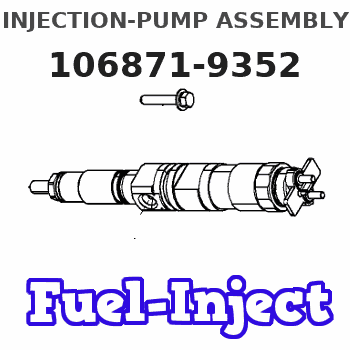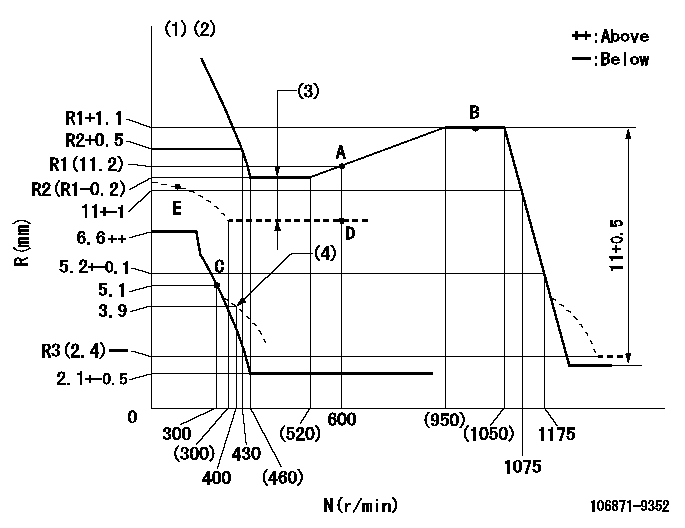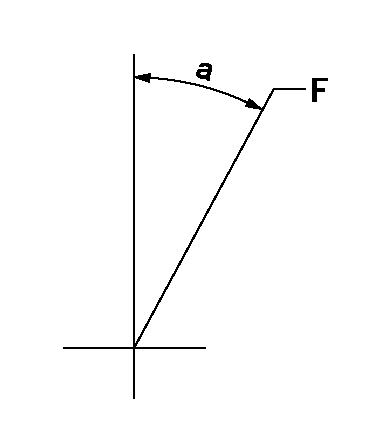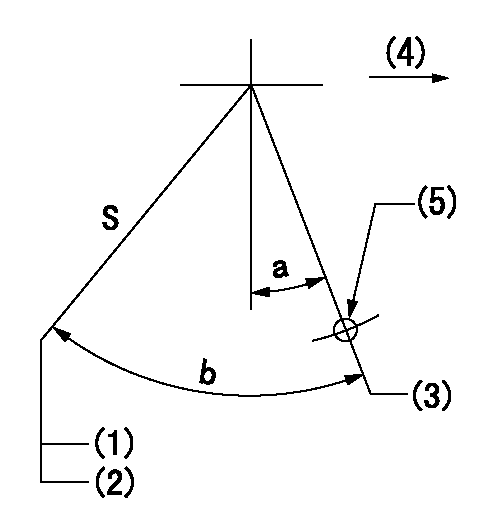Information injection-pump assembly
BOSCH
F 019 Z20 278
f019z20278
ZEXEL
106871-9352
1068719352

Rating:
Service parts 106871-9352 INJECTION-PUMP ASSEMBLY:
1.
_
7.
COUPLING PLATE
8.
_
9.
_
11.
Nozzle and Holder
12.
Open Pre:MPa(Kqf/cm2)
17.7{180}
15.
NOZZLE SET
Include in #1:
106871-9352
as INJECTION-PUMP ASSEMBLY
Cross reference number
BOSCH
F 019 Z20 278
f019z20278
ZEXEL
106871-9352
1068719352
Zexel num
Bosch num
Firm num
Name
106871-9352
F 019 Z20 278
DPICO
INJECTION-PUMP ASSEMBLY
8DC9T2 Q
8DC9T2 Q
Calibration Data:
Adjustment conditions
Test oil
1404 Test oil ISO4113 or {SAEJ967d}
1404 Test oil ISO4113 or {SAEJ967d}
Test oil temperature
degC
40
40
45
Nozzle and nozzle holder
105780-8140
Bosch type code
EF8511/9A
Nozzle
105780-0000
Bosch type code
DN12SD12T
Nozzle holder
105780-2080
Bosch type code
EF8511/9
Opening pressure
MPa
17.2
Opening pressure
kgf/cm2
175
Injection pipe
Outer diameter - inner diameter - length (mm) mm 8-3-600
Outer diameter - inner diameter - length (mm) mm 8-3-600
Overflow valve
131424-4620
Overflow valve opening pressure
kPa
255
221
289
Overflow valve opening pressure
kgf/cm2
2.6
2.25
2.95
Tester oil delivery pressure
kPa
157
157
157
Tester oil delivery pressure
kgf/cm2
1.6
1.6
1.6
Direction of rotation (viewed from drive side)
Right R
Right R
Injection timing adjustment
Direction of rotation (viewed from drive side)
Right R
Right R
Injection order
1-2-7-3-
4-5-6-8
Pre-stroke
mm
3.4
3.35
3.45
Beginning of injection position
Governor side NO.1
Governor side NO.1
Difference between angles 1
Cyl.1-2 deg. 45 44.5 45.5
Cyl.1-2 deg. 45 44.5 45.5
Difference between angles 2
Cal 1-7 deg. 90 89.5 90.5
Cal 1-7 deg. 90 89.5 90.5
Difference between angles 3
Cal 1-3 deg. 135 134.5 135.5
Cal 1-3 deg. 135 134.5 135.5
Difference between angles 4
Cal 1-4 deg. 180 179.5 180.5
Cal 1-4 deg. 180 179.5 180.5
Difference between angles 5
Cal 1-5 deg. 225 224.5 225.5
Cal 1-5 deg. 225 224.5 225.5
Difference between angles 6
Cal 1-6 deg. 270 269.5 270.5
Cal 1-6 deg. 270 269.5 270.5
Difference between angles 7
Cal 1-8 deg. 315 314.5 315.5
Cal 1-8 deg. 315 314.5 315.5
Injection quantity adjustment
Adjusting point
-
Rack position
11.2
Pump speed
r/min
600
600
600
Each cylinder's injection qty
mm3/st.
167
162
172
Basic
*
Fixing the rack
*
Standard for adjustment of the maximum variation between cylinders
*
Injection quantity adjustment_02
Adjusting point
C
Rack position
5.1+-0.5
Pump speed
r/min
300
300
300
Each cylinder's injection qty
mm3/st.
14
11.9
16.1
Fixing the rack
*
Standard for adjustment of the maximum variation between cylinders
*
Injection quantity adjustment_03
Adjusting point
A
Rack position
R1(11.2)
Pump speed
r/min
600
600
600
Average injection quantity
mm3/st.
167
166
168
Basic
*
Fixing the lever
*
Boost pressure
kPa
48
48
Boost pressure
mmHg
360
360
Injection quantity adjustment_04
Adjusting point
B
Rack position
R1+1.1
Pump speed
r/min
1000
1000
1000
Average injection quantity
mm3/st.
185.5
181.5
189.5
Fixing the lever
*
Boost pressure
kPa
48
48
Boost pressure
mmHg
360
360
Injection quantity adjustment_05
Adjusting point
E
Rack position
-
Pump speed
r/min
100
100
100
Average injection quantity
mm3/st.
135
95
175
Fixing the lever
*
Boost pressure
kPa
0
0
0
Boost pressure
mmHg
0
0
0
Boost compensator adjustment
Pump speed
r/min
500
500
500
Rack position
R2-0.85
Boost pressure
kPa
24
22.7
25.3
Boost pressure
mmHg
180
170
190
Boost compensator adjustment_02
Pump speed
r/min
500
500
500
Rack position
R2(R1-0.
2)
Boost pressure
kPa
34.7
28
41.4
Boost pressure
mmHg
260
210
310
Timer adjustment
Pump speed
r/min
650--
Advance angle
deg.
0
0
0
Remarks
Start
Start
Timer adjustment_02
Pump speed
r/min
600
Advance angle
deg.
0.5
Timer adjustment_03
Pump speed
r/min
900
Advance angle
deg.
4
3.5
4.5
Remarks
Finish
Finish
Test data Ex:
Governor adjustment

N:Pump speed
R:Rack position (mm)
(1)Tolerance for racks not indicated: +-0.05mm.
(2)Microswitch not operating at delivery.
(3)Boost compensator stroke: BCL
(4)Damper spring setting
----------
BCL=0.85+-0.1mm
----------
----------
BCL=0.85+-0.1mm
----------
Speed control lever angle

F:Full speed
----------
----------
a=(15deg)+-5deg
----------
----------
a=(15deg)+-5deg
0000000901

F:Full load
I:Idle
(1)Stopper bolt setting
----------
----------
a=10deg+-5deg b=32deg+-3deg
----------
----------
a=10deg+-5deg b=32deg+-3deg
Stop lever angle

S:Stop the pump.
(1)Rack position = aa
(2)Stopper bolt setting
(3)Free (at delivery)
(4)Drive side
(5)Use the hole at R = bb
----------
aa=3.5-0.5mm bb=32mm
----------
a=10.5deg+-5deg b=57.5deg+7deg-5deg
----------
aa=3.5-0.5mm bb=32mm
----------
a=10.5deg+-5deg b=57.5deg+7deg-5deg
0000001501 GOVERNOR TORQUE CONTROL

Dr:Torque control stroke
(A): Without torque control spring capsule
1. Adjustment procedures
(1)Procedure is the same as that for the RFD (former type), except that the positive torque control stroke must be determined at the full lever setting.
2. Procedures for adjustment
(1)Remove the torque control spring capsule.
(2)Operate the pump at approximately N1. (End of idling spring operation < N1.)
(3)Tilt the lever to the full side.
(4)Set so that R = RF.
(5)Increase the speed by pushing in the screw (attached to the bracket on the rear of the tension lever) through the adjusting window.
(6)Adjust so that the torque control stroke Dr1 can be obtained.
(7)Align N2 and N3 with the torque control spring capsule.
3. Final confirmation
(1)After final confirmation, temporarily set the load lever to N = N1, R = idling position.
(2)From this condition, increase speed to N = N4.
(3)Confirm that positive torque control stroke is Dr2.
----------
N1=500r/min N2=(520)r/min N3=(950)r/min N4=1000r/min RF=11mm Dr1=1.3mm Dr2=0+0.3mm
----------
----------
N1=500r/min N2=(520)r/min N3=(950)r/min N4=1000r/min RF=11mm Dr1=1.3mm Dr2=0+0.3mm
----------
Timing setting

(1)Pump vertical direction
(2)Coupling's key groove position at No 1 cylinder's beginning of injection
(3)B.T.D.C.: aa
(4)-
----------
aa=14deg
----------
a=(40deg)
----------
aa=14deg
----------
a=(40deg)
Information:
Engine Crankshaft Will Not Turn
Possible Causes/Corrections
Low or No Battery Voltage/Check battery voltage. If battery voltage is less than 8 volts for a 12 volt system, or 16 volts for a 24 volt system, put a charge to the battery. If battery will not hold a charge, load test the battery as shown in the ELECTRICAL SYSTEM of the Testing and Adjusting section of this Service Manual. Bad Switch, Bad Wiring or Connection in Switch Circuit/With ignition switch in START position, check voltage at switch connection on starter solenoid. If there is no voltage, or if the voltage is low at this connection, check wiring, connections, ignition switch, and magnetic switch (if used). Bad Cable or Connection; Battery to Starter/With ignition switch in the START position, check voltage at connection of battery cable to starter. If there is no voltage, or if the voltage is low at this connection and there is good voltage at the battery, check for bad cable or connection between the battery and the starter. Bad Starter Solenoid/Remove and repair a solenoid which does not work when voltage is correct at both the battery and ignition switch connections. Bad Starter Motor/If the solenoid works and the starter motor does not turn the crankshaft, the starter motor is bad. Before removing the starter motor, turn the crankshaft by hand to be sure a mechanical failure inside the engine, transmission, or power take-off is not preventing the crankshaft from turning. If crankshaft turns freely by hand, engage the starter motor again. If the starter motor still will not work, remove the starter motor and repair it, or install a new starter motor. Transmission or Power Take-off (if so equipped) Problem Prevents Crankshaft From Turning/If crankshaft can not be turned by hand, disconnect the transmission and power take-off. If crankshaft will now turn, find the cause of the problem in the transmission or power take-off and make necessary corrections. Inside Problem Prevents Engine Crankshaft From Turning/If the crankshaft can not be turned after disconnecting the transmission and power take-off, remove the fuel nozzles and check for fluid in the cylinders while turning the crankshaft. If fluid in the cylinders is not the problem, the engine must be disassembled to check for other inside problems. Some of these inside problems are bearing seizure, piston seizure, and valves making contact with pistons.Engine Crankshaft Turns Too Slowly
Possible Causes/Corrections
Low Battery Voltage/Check battery voltage. If battery voltage is less than 8 volts for a 12 volt system, or 16 volts for a 24 volt system, put a charge to the battery. If the battery will not hold a charge, load test the battery as shown in the ELECTRICAL SYSTEM of the Testing and Adjusting section of this Service Manual. Bad Cable or Connection; Battery to Starter/With switch in START position, check voltage at battery cable connection to starter. If voltage is low at this connection and there is good voltage at the battery, check for bad cable or connection between the battery and
Possible Causes/Corrections
Low or No Battery Voltage/Check battery voltage. If battery voltage is less than 8 volts for a 12 volt system, or 16 volts for a 24 volt system, put a charge to the battery. If battery will not hold a charge, load test the battery as shown in the ELECTRICAL SYSTEM of the Testing and Adjusting section of this Service Manual. Bad Switch, Bad Wiring or Connection in Switch Circuit/With ignition switch in START position, check voltage at switch connection on starter solenoid. If there is no voltage, or if the voltage is low at this connection, check wiring, connections, ignition switch, and magnetic switch (if used). Bad Cable or Connection; Battery to Starter/With ignition switch in the START position, check voltage at connection of battery cable to starter. If there is no voltage, or if the voltage is low at this connection and there is good voltage at the battery, check for bad cable or connection between the battery and the starter. Bad Starter Solenoid/Remove and repair a solenoid which does not work when voltage is correct at both the battery and ignition switch connections. Bad Starter Motor/If the solenoid works and the starter motor does not turn the crankshaft, the starter motor is bad. Before removing the starter motor, turn the crankshaft by hand to be sure a mechanical failure inside the engine, transmission, or power take-off is not preventing the crankshaft from turning. If crankshaft turns freely by hand, engage the starter motor again. If the starter motor still will not work, remove the starter motor and repair it, or install a new starter motor. Transmission or Power Take-off (if so equipped) Problem Prevents Crankshaft From Turning/If crankshaft can not be turned by hand, disconnect the transmission and power take-off. If crankshaft will now turn, find the cause of the problem in the transmission or power take-off and make necessary corrections. Inside Problem Prevents Engine Crankshaft From Turning/If the crankshaft can not be turned after disconnecting the transmission and power take-off, remove the fuel nozzles and check for fluid in the cylinders while turning the crankshaft. If fluid in the cylinders is not the problem, the engine must be disassembled to check for other inside problems. Some of these inside problems are bearing seizure, piston seizure, and valves making contact with pistons.Engine Crankshaft Turns Too Slowly
Possible Causes/Corrections
Low Battery Voltage/Check battery voltage. If battery voltage is less than 8 volts for a 12 volt system, or 16 volts for a 24 volt system, put a charge to the battery. If the battery will not hold a charge, load test the battery as shown in the ELECTRICAL SYSTEM of the Testing and Adjusting section of this Service Manual. Bad Cable or Connection; Battery to Starter/With switch in START position, check voltage at battery cable connection to starter. If voltage is low at this connection and there is good voltage at the battery, check for bad cable or connection between the battery and
Have questions with 106871-9352?
Group cross 106871-9352 ZEXEL
Dpico
106871-9352
F 019 Z20 278
INJECTION-PUMP ASSEMBLY
8DC9T2
8DC9T2